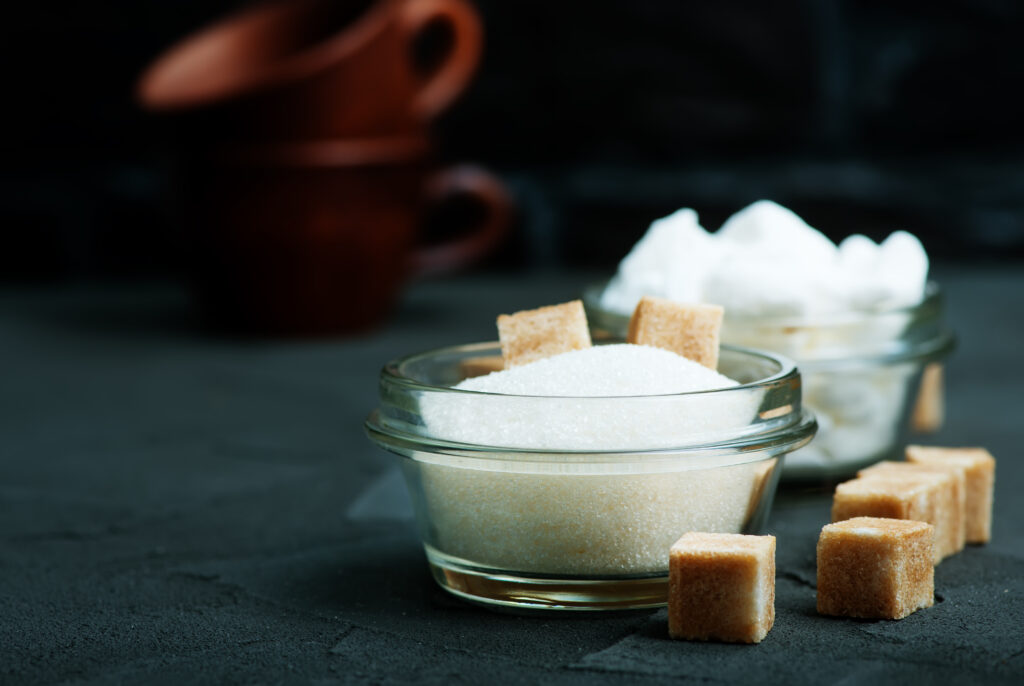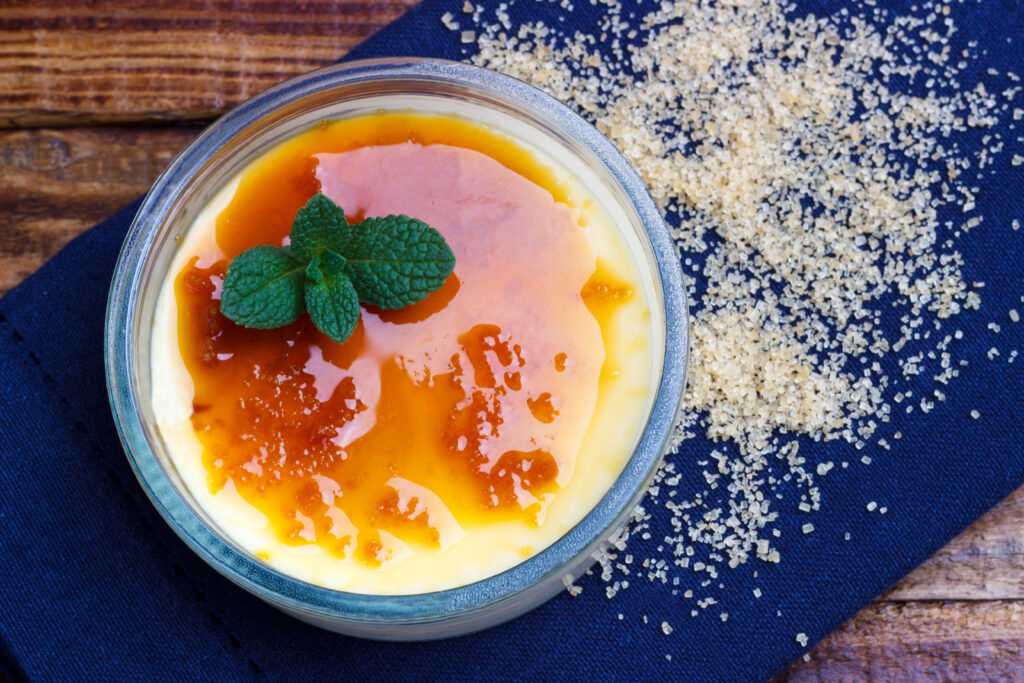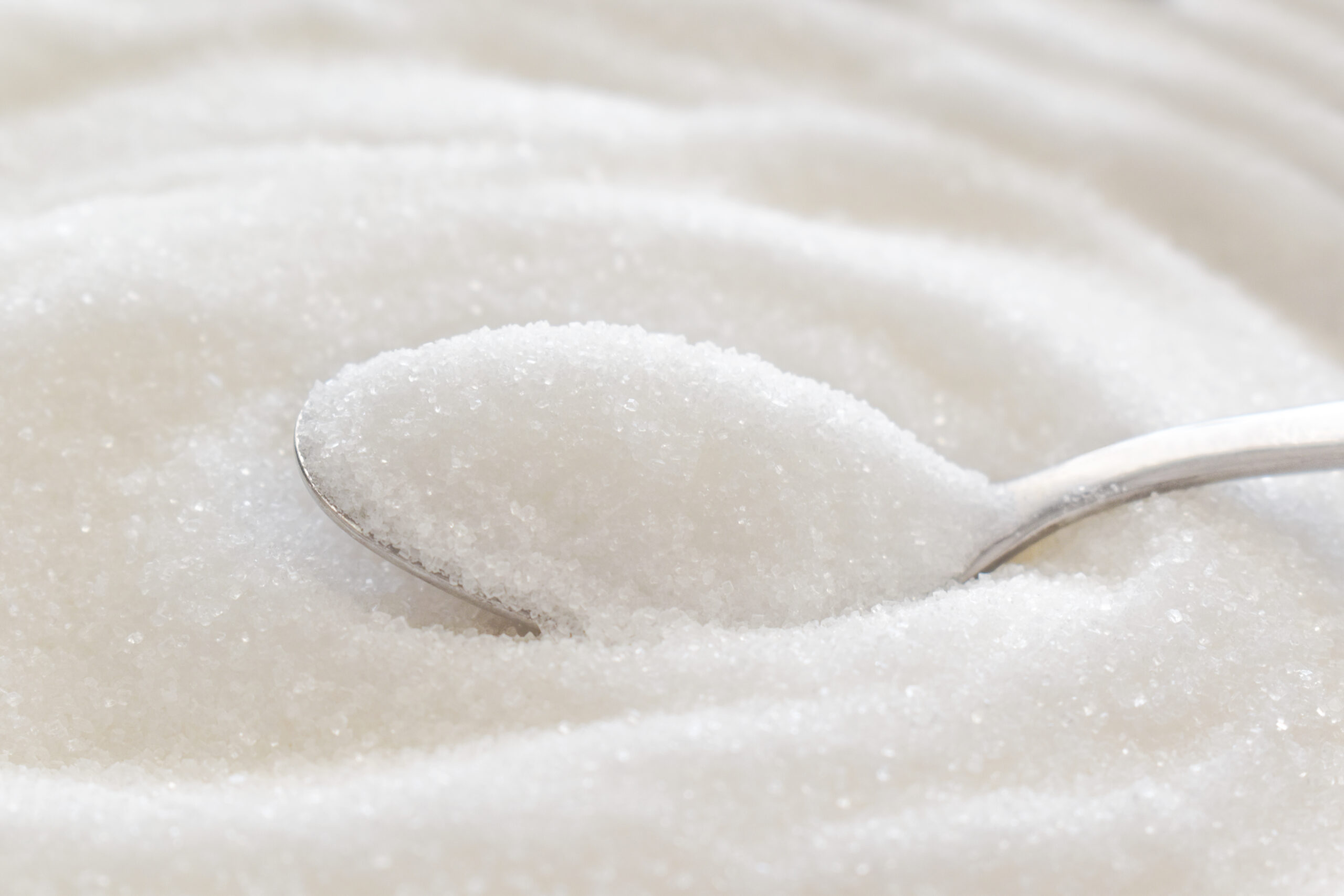Introduction to Crème Brûlée
Which type of sugar is optimal for creating the perfect caramelized topping on crème brûlée? Discovering the ideal sugar type is essential in mastering the art of crème brûlée, a beloved dessert known for its rich custard base and a uniquely crisp caramelized top.
The process of caramelization not only enhances flavor but also introduces a delightful textural contrast, crucial for the classic crème brûlée experience.
This introduction to caramelization will explore why this technique is central to perfecting the dessert’s signature feature.
Best Sugars for Caramelization

Overview of Sugars Used in Crème Brûlée
Crème brûlée requires a delicate balance of ingredients to achieve its iconic taste and texture, with sugar playing a pivotal role.
Here, we explore the most common types of sugar used to create that perfect caramelized top: granulated, superfine, and raw sugars.
Granulated Sugar: This is the most commonly used sugar in kitchens worldwide. It caramelizes evenly and quickly, making it a reliable choice for achieving a smooth, crisp topping.
Its regular crystal size allows for consistent melting and browning, essential for that classic crème brûlée crunch.
Superfine Sugar: Also known as caster sugar, superfine sugar has smaller crystals than granulated sugar.
It melts faster and more evenly, reducing the risk of burning before the sugar caramelizes. This characteristic makes it an excellent option for those seeking a finer, more delicate crust.
Raw Sugars: Sugars like turbinado and demerara fall into the raw sugar category. They are less processed and retain some of the natural molasses, giving them a richer flavor.
However, their larger crystals can be a challenge to melt evenly. They often require grinding to finer consistency for more uniform caramelization.
Each type of sugar brings a unique element to the dessert, influencing not only the texture of the caramelized layer but also the overall flavor profile of the dish.
Whether you prefer the classic approach with granulated sugar or a richer flavor from raw sugars, understanding these variations can enhance your crème brûlée experience.
Benefits of Using Granulated Sugar

Granulated sugar is widely favored in crème brûlée recipes for several key reasons. Its fine texture and consistent melting properties make it ideal for achieving a perfectly caramelized top.
Consistency and Availability: Granulated sugar is the most readily available sugar and comes with a uniform grain size that offers predictability in recipes.
This uniformity is crucial for consistent results in desserts, particularly in caramelization.
Even Caramelization: The fine grains of granulated sugar melt evenly, reducing the risk of burning spots. This even melting is essential for forming a smooth, evenly browned crust that crème brûlée is famous for.
It ensures that the entire surface caramelizes at the same rate, providing that satisfying crack when tapped with a spoon.
Texture and Flavor: While granulated sugar doesn’t impart the deeper flavors that raw sugars might, its neutrality enhances the natural flavors of the other ingredients in the custard.
The refined sugar caramelizes into a pure, sweet crust without any molasses undertones, which could potentially overpower the delicate vanilla and cream notes of the dessert.
Ease of Use: For home cooks and chefs alike, the predictable behavior of granulated sugar under heat makes it a safe choice. It does not require any alteration like grinding or processing before use, which can be necessary with coarser sugars.
Ultimately, the choice of granulated sugar for crème brûlée is rooted in its ability to deliver a consistent, evenly caramelized surface every time, making it a reliable choice for both novice and experienced bakers.
This reliability, coupled with its availability, makes granulated sugar a go-to for this classic dessert.
Superfine Sugar: A Close Contender
Superfine sugar, also known as caster sugar, holds several advantages when it comes to creating a smooth, crisp topping for crème brûlée. Its distinct properties make it a popular choice among bakers and chefs for achieving an ideal caramelized crust.
Fine Texture: Superfine sugar has much smaller crystals than regular granulated sugar. This fine texture allows it to dissolve and melt more quickly and evenly. The rapid melting helps prevent the sugar from burning before it caramelizes, ensuring a smoother topping without granules.
Uniform Caramelization: Because of its consistency, superfine sugar spreads more uniformly over the custard surface.
This even distribution is crucial for achieving a consistent caramel layer that covers the entire top of the crème brûlée without clumping or leaving patches uncovered.
Enhanced Mouthfeel: The smaller crystals of superfine sugar also contribute to a finer, crisper crust that breaks beautifully with each spoonful. This creates a delightful contrast to the creamy custard below, enhancing the textural experience of the dessert.
Quick Reaction Time: Superfine sugar’s ability to react quickly under heat makes it particularly useful for chefs who need to prepare multiple servings of crème brûlée efficiently. Its quick caramelization time helps speed up the preparation process without sacrificing quality.
Versatility: While superfine sugar is excellent for caramelization, its fine texture also makes it suitable for more delicate desserts that require sugar to dissolve quickly and without residue, proving its versatility in the kitchen.
In conclusion, superfine sugar’s fine grains and fast dissolving nature make it a close contender to granulated sugar, particularly when a smooth and even caramelized topping is desired.
Its ability to create a consistently crisp layer while maintaining a quick reaction time under the torch makes it an appealing choice for perfecting the finish of crème brûlée.
The Caramelization Process
How to Caramelize Sugar on Crème Brûlée

Caramelizing sugar on crème brûlée is a crucial step that gives this dessert its signature taste and texture. Here’s a step-by-step guide to using either a torch or a broiler to achieve that perfect golden crust.
Using a Torch
- Prepare Your Station: Ensure the crème brûlée is completely chilled and set before beginning. Place your ramekins on a heat-resistant surface.
- Sprinkle the Sugar: Evenly distribute a thin layer of superfine sugar over the surface of each custard. The thinness ensures it will melt quickly and evenly.
- Light Your Torch: Turn on your torch and adjust it to a medium flame.
- Torch the Sugar: Hold the torch about six inches away from the surface. Move it slowly in a circular motion over the sugar, ensuring not to linger too long in one spot to prevent burning.
- Cool Before Serving: Allow the crème brûlée to sit for a few minutes after torching. This lets the sugar harden into a glossy, crisp topping.
Using a Broiler
- Preheat the Broiler: Set your oven’s broiler on high and let it preheat.
- Prepare the Ramekins: Just like with torching, sprinkle a thin layer of sugar over each custard.
- Broil the Sugar: Place ramekins under the broiler. Keep the oven door slightly open and watch closely—the sugar should start caramelizing within a minute or so.
- Monitor Closely: As soon as the sugar melts and turns golden brown, remove the ramekins. This process happens fast and can vary, so constant vigilance is necessary to avoid burning.
Final Touches and Tips for Success
- After caramelization, whether using a torch or broiler, it’s important to let the crème brûlée cool for a couple of minutes. This helps the sugar crust fully solidify, creating that satisfying crack when tapped with a spoon.
- Always ensure your custards are cold before adding sugar; this helps achieve a sharp contrast in temperatures needed for a crisp top.
- If the sugar starts to burn, pull back the torch or remove the ramekins from the broiler immediately to prevent a bitter taste.
These steps and tips will help you master the art of caramelization, enhancing your crème brûlée with the perfect balance of sweet, crunchy topping and creamy, smooth custard below.
Common Mistakes and How to Avoid Them
Creating the perfect caramelized top on crème brûlée can be tricky, and several common issues can arise. Here’s how to identify and avoid these pitfalls:
Uneven Caramelization:
- Cause: Uneven caramelization typically occurs when the sugar is not spread evenly or the heat source is not distributed uniformly.
- Solution: Ensure that the sugar layer is even before you begin caramelizing. Use a sieve to sprinkle the sugar if necessary. Keep the torch or broiler moving constantly to avoid hotspots.
Sugar Burns Before Melting:
- Cause: This often happens when the heat is too high or the sugar is left under the heat too long.
- Solution: Maintain a moderate flame and keep it moving. If using a broiler, watch closely and remove the crème brûlée as soon as you see the sugar bubbling and starting to brown.
Custard Becomes Too Runny:
- Cause: Overheating the custard during the caramelization process can cause it to become runny.
- Solution: Ensure the custard is thoroughly chilled before adding the sugar. This keeps the custard firm even if the top gets hot.
Grainy Caramel Layer:
- Cause: Using sugar that is too coarse can result in a grainy texture as it may not melt completely.
- Solution: Opt for superfine sugar, which melts more quickly and smoothly, or pulse your regular sugar in a food processor.
Sugar Not Caramelizing:
- Cause: Sometimes the sugar just won’t caramelize, often due to moisture.
- Solution: Ensure the top of the custard is dry before applying sugar, and use a dry spoon or scoop for the sugar.
By understanding these common issues and how to counteract them, you can improve your technique and ensure a flawless finish on your crème brûlée. Always take your time to prepare properly, and don’t rush the caramelization process—patience is key!
Advanced Tips and Techniques
Experimenting with Other Sugars
Exploring different types of sugars like turbinado or demerara can add unique flavors and textures to your crème brûlée. These raw sugars are known for their larger crystals and natural, molasses-like flavor, which can enhance the dessert with a more complex sweetness.
- Turbinado Sugar: This sugar, often marketed as “raw sugar,” has large, light brown crystals that are partially refined. It retains some natural molasses, giving it a richer flavor compared to white sugar. When used for caramelization, turbinado sugar provides a slightly deeper flavor with a hint of toffee, which complements the creamy custard wonderfully.
- Demerara Sugar: Similar to turbinado, demerara sugar comes from sugar cane and features large, crunchy crystals. It has a slightly sticky texture with a molasses flavor that is a bit milder than turbinado but more pronounced than that of granulated sugar. The larger crystals of demerara sugar offer a more pronounced crunch and aesthetic appeal when caramelized, creating a delightful contrast to the smooth custard.
When using these sugars, it’s crucial to adjust your caramelization technique slightly. Due to their larger crystal size, both turbinado and demerara may require a longer time under heat to melt completely and evenly. Experimenting with these sugars can introduce new flavors and textures, making your crème brûlée uniquely delicious.
Using raw sugars like turbinado or demerara can transform your crème brûlée into an even more indulgent treat, giving it a rustic charm and enhanced flavor that sets it apart from those made with refined sugars.
Innovative Caramelization Techniques
Exploring alternative caramelization methods can be a game-changer for those without a kitchen torch. One innovative technique is using a heated spoon.
- Using a Heated Spoon: This method involves heating a metal spoon over a stove flame until it is very hot. Once heated, the back of the spoon is pressed gently against the sugar-coated surface of the crème brûlée. The heat from the spoon melts the sugar, creating a caramelized top. This method requires patience and a steady hand to ensure even caramelization without overheating any particular area.
- Advantages: This technique is accessible to anyone with a stove and a spoon. It offers a way to achieve that desirable caramelized crust without special equipment.
- Technique Tips: Ensure the spoon is not overly hot as it can burn the sugar rather than caramelizing it. Move the spoon around to different parts of the dessert’s surface to evenly distribute the heat.
- Considerations: The heated spoon method may not produce as uniform a crust as a torch, but it can still offer a delightful texture and flavor to the dessert. Additionally, it allows for immediate control over the caramelization process, as you can quickly move the spoon away if the sugar starts to burn.
Experimenting with this technique can add a touch of artisanal craft to the preparation of crème brûlée, providing a satisfying alternative to traditional methods and showcasing your adaptability in the kitchen.
FAQs on Caramelizing Sugar for Crème Brûlée
What type of sugar is best for caramelizing on crème brûlée? Superfine sugar is often preferred because it melts quickly and evenly, creating a smooth, glossy caramelized top.
Is it possible to caramelize sugar on crème brûlée if I don’t have a torch? Yes, you can use a broiler instead. Place the sugared crème brûlée under a preheated broiler, watching closely until the sugar melts and turns golden.
How thick should the sugar layer be for perfect caramelization? A thin, even layer of sugar is ideal. Too much sugar can result in a thick, hard crust that is difficult to break.
Why does my sugar burn instead of caramelizing? This usually happens if the torch is held too close to the sugar or if it’s left in one spot for too long. Keep the torch moving and hold it at a reasonable distance.
How long should I let the crème brûlée cool after caramelizing the sugar? Allow the crème brûlée to sit for at least 5 minutes after caramelizing the sugar. This lets the sugar crust harden, creating that signature crisp top.
By understanding these aspects, you can enhance your technique and enjoy a perfectly caramelized crème brûlée every time.
Conclusion: Summary and Best Practices
Choosing the right sugar is crucial for crafting the perfect crème brûlée with a beautifully caramelized top. Granulated sugar is most commonly recommended due to its fine texture and consistent melting properties, making it ideal for beginners. Superfine sugar, on the other hand, melts even more quickly and is excellent for achieving a smooth, even crust.
For those looking to add a unique flavor and texture, experimenting with raw sugars like turbinado might offer delightful results. Remember, the key to perfect caramelization lies in even application and careful heating. Whether using a torch or broiler, keep the heat moving to avoid burning and ensure a gorgeous, golden finish that complements the creamy custard beneath.

